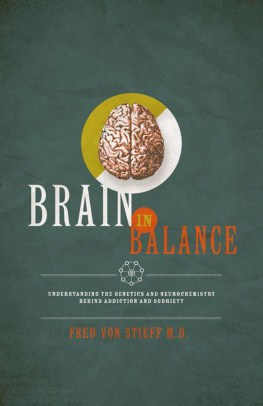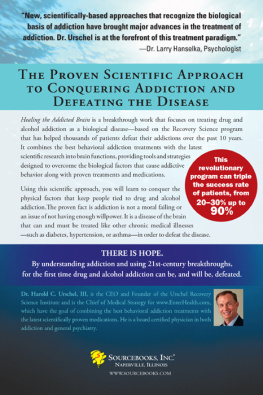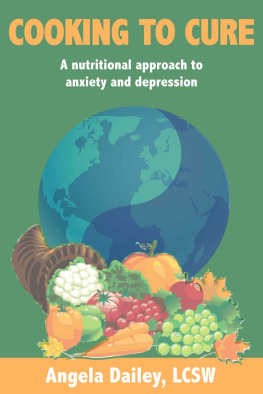BRAIN IN BALANCE
UNDERSTANDING THE GENETICS AND NEUROCHEMISTRY BEHIND ADDICTION AND SOBRIETY
Fred erick Von Stieff M.D.
First Edition
Canyon Hill Publishing
Copyright 2011 by Fred erick Von Stieff M.D.
Kindle Edition published January 2012
ISBN 978-0-9839518-1-0
While we have tried to ensure the accuracy of the contents in this book, the author or publishers cannot be held responsible for any errors or omissions found therein.
All rights reserved. This eBook is licensed for your personal use only. This eBook may not be resold or given away to other people. No part of this eBook may be reproduced or transmitted in any form or by any means, electronic or mechanical or by any information storage and retrieval system, without permission in writing from the author. If you are reading this eBook but did not purchase it, you are requested to buy your own copy. Thank you for respecting the hard work of this author.
This edition was edited and prepared for publishing by Katie Jane Schuh de Juarez
Illustrations by Elizabeth Zunino
Cover design by Chen Design
www.braininbalancebook.com
Contents
About the Author
Preface
Acknowledgments
Introduction
Chapter 1
The Brain A Complex, yet Predictable Organ
Rules for the Brain???
For Every Action, There is a Reaction
Why You Need to Know the Basics
Why Use This System
Chapter 2
Addressing Neurochemical Balances: Validity of this Method
A Common Methodological Blunder
Evaluation and Success
Relapse: The Measure of Achievement
No Longer Just a Theory
Chapter 3
Neurotransmitter Basics
The Serotonin System
The Dopamine System
The GABA System
The Glutamate System
The Opiate System
The Noradrenergic System
The Endocannabinoid System
The Acetylcholine System
The Neurotransmitter Systems Interdependence and Influence
Chapter 4
Genetics: The Source of Addiction
Inheritance on Chemical Dependency Problems
Basic Genetics
Neuroanatomy Basics
The Art of Brain Chemical Treatment
Searching for the Clues that Lead to Answers
Alcoholic Rats
The Depressant Antidepressant
The Powerful Drive to Feel (Better Than) Normal
An Application of the Inquiry Method
Chapter 5
Tolerance, Withdrawal, and Detoxification
Disabling Neurochemical Receptor Sites
Swarming Receptor Sites
Down-Regulation in the Hospital
Tolerance and Addiction
Tolerance Begets Withdrawal
Detoxification The Process of Up-Regulation
The Danger of Going Back
Chapter 6
Nature and Nurture
Neurotransmitters and Personality
Harnessing the Power of Neurotransmitters
Depression and Alcoholism
Long-Term Treatment of Genetic Imbalances
Chapter 7
The Power of Alcohol and Nicotine
The Most Powerful Drug and its Accomplice
Nicotine and Acetylcholine
Quitting the Nicotine
Why We Drink and Cannot Stop
The Magic of 28 Days
The Old Method of Treatment
The New Method of Treatment: Focus on the Cravings
Chapter 8
Treating Alcoholics
Addressing Underlying Problems
GABA versus Glutamate
Levels of Acute Alcohol Withdrawal Syndrome
Combating Seizure Activity
How to Use the GABA System during the Detoxification Phase of Treatment
Medications to Suppress Cravings
Chapter 9
Memory and Chemical Dependency
Imprinting Memories
Memory How it Works and How it is Altered
Flashbacks and Blackouts
Altered Data Means Inaccurate Memories
Intuition
Fixing Perceptions and Reframing Data
Chapter 10
Assisting Alcoholics and Addicts:
Through Negotiations and in the Intensive Care Unit
Psychodynamics of an Alcoholic Resisting Treatment
Health Problems
Methods of Negotiation: Dealing with Alcoholics and Addicts Successfully
A Look at the ICU
Strategies in the ICU
Chapter 11
Victims of the Opiate Craze
Pain Management
Cross-Addiction: Alcohol and the Opiate System
Bipolar Patients and the Opiate System
The Devastating Effects of Opiate Abuse
Chapter 12
Treating Opiate Addiction
Common Treatment for Opiate Addicts
Use the GABA System
Getting Patients with Pain Control Issues Back on their Natural Opiates
Treating Underlying Disorders of Genetic Alcoholic Opiate Addicts
Opiates, GABA, and Dopamine
Summary of Treating Opiate Addicts
Chapter 13
The Future of Chemical Dependency Treatment
Know Your GABA: Use the Other Sites
Dopamine and Chemical Dependency: Why the Future of Dopaminergic Medications is so Important to the Field of Detoxification and Neurochemistry
Genetics Potential for Future Chemical Dependency Treatment
The Step in Between
How to Visualize Patients Neurotransmitter Systems
Instructions on How to Use the Neurotransmitter Diagram
Using Medications to Stop Cravings
An Introduction to a Drug Index
Drug Index
Case Studies
Case Study #1 Modafinil Detoxification
Case Study #2 Anticipating Neurotransmitter Reactions
Case Study #3 OxyContin Abuse
Case Study #4 Benzodiazepine and Opiate Detoxification of a Self-Medicating Bipolar Patient
Case Study #5 Benzodiazepine Withdrawal
Case Study #6 An Opiate and Alcohol Detoxification
Case Study #7 Bipolar Patient Addicted to Opiates
Case Study #8 A Genetic Alcoholic on Opiates
Case Study #9 Common Complications in the ICU
Case Study#10 Off the Ventilator and Extubated
Case Study #11 Acute Opiate Withdrawal in the Hospital
Case Study #12 Xanax and a GABA Deficiency
Case Study #13 Treating a Dopamine Deficiency
Case Study #14 The Unpredictable GABA1a Site
A Final Word
About the Author
Dr. Von Stieff is a recognized expert in the field of chemical dependency treatment. He is a board-certified addictionologist who has successfully detoxified over 20,000 patients in hospital-based programs. He has worked as the Medical Director for three different chemical dependency programs over the course of twenty years and is certified by the American Board of Addiction Medicine, the American Society of Addiction Medicine, and the California Society of Addiction Medicine. He is currently the Chief Medical Review Officer for the State of California and a legal expert in substance abuse, carrying additional titles in that field.
He comes from humble beginnings in central Nevada and started his higher education at the University of Nevada. He graduated from the University of California Irvine Medical School and then completed a family practice residency at the University of California Davis. He then began working at hospitals in the East Bay of San Francisco, where he not only worked in chemical dependency, but also spent time working as an assistant in both vascular surgery and brain surgery. It was during that time of striving to understand the brain better and working in a chemical dependency program, that he began to develop many new, innovative ideas about detoxification and treatment.
At first Dr. Von Stieff went through a phase of feeling distrust, annoyance, and even anger towards addicts and alcoholics, but he soon realized there was more behind their addiction than just a series of bad life choices. Something else was going on within their brains that provided a further explanation for their actions. After working with these addicted individuals that he once viewed as disgraceful, he found that they actually had a number of reputable qualities such as intelligence, charm, and humor. So what was the difference between them and the rest of society? They just had an affliction its source being neurochemical, which needed special treatment. They required innovative ways to keep them out of harms way and prevent them from losing their lives due to the consequences of some state of mind not in congruence with their character.
Next page











